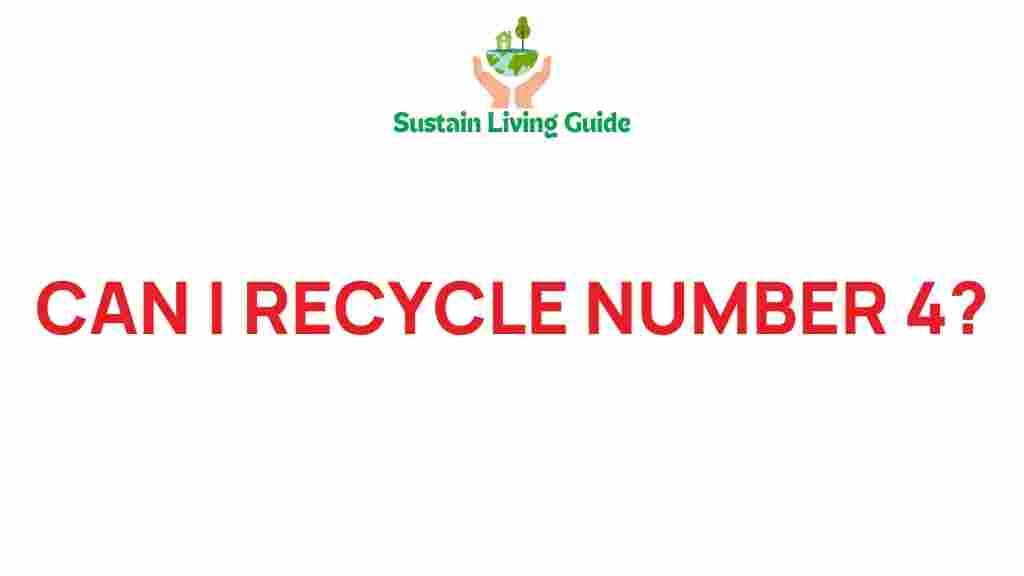Recycling Number 4 Plastics: What You Need to Know
Every day, millions of people engage in the process of recycling, yet many remain unaware of the specifics surrounding various types of plastics. Among these, Number 4 plastics, known as low-density polyethylene (LDPE), often raise questions about their recyclability. In this article, we will unravel the mystery of whether you can really recycle Number 4 plastics and how you can contribute to a more sustainable environment through effective recycling practices.
Understanding Number 4 Plastics
Before diving into the recycling process, it’s essential to understand what Number 4 plastics are and where they are commonly found. LDPE is a flexible plastic often used in:
- Grocery bags
- Food wraps
- Some containers
- Plastic lids
- Shrink wraps
These plastics are marked with a recycling symbol that features the number 4 inside. Although they are widely used, many people are unsure about their recyclability.
Can You Recycle Number 4 Plastics?
The answer to whether you can recycle Number 4 plastics is somewhat complex. While technically, LDPE can be recycled, the availability of recycling programs that accept these materials varies significantly by location. Here are some key points to consider:
- Local Regulations: Check with your local waste management authority to see if they accept Number 4 plastics for recycling.
- Recycling Facilities: Not all recycling facilities are equipped to handle LDPE, so it’s crucial to find one that does.
- Collection Programs: Some grocery stores and retailers have designated drop-off bins for recycling plastic bags and wraps.
The Recycling Process for Number 4 Plastics
If your local facility accepts Number 4 plastics, here’s a step-by-step process of how recycling works:
Step 1: Collection and Sorting
The first step involves collecting and sorting the plastics. When you recycle LDPE, it is usually collected with other plastics and then sorted at a recycling facility. This sorting process is crucial for ensuring that the materials are appropriately processed.
Step 2: Cleaning
Once sorted, the plastics need to be cleaned. Contaminants such as food residues, dirt, or other materials can hinder the recycling process. Clean LDPE is essential for successful recycling.
Step 3: Shredding
The cleaned LDPE is then shredded into small pieces. This makes it easier to process and melt down during the recycling phase.
Step 4: Melting and Reforming
The shredded plastic is then melted down and formed into pellets. These pellets can be used to create new plastic products, thus giving a second life to the materials.
Challenges of Recycling Number 4 Plastics
While recycling Number 4 plastics is possible, there are several challenges involved:
- Limited Infrastructure: Not all communities have the infrastructure required to recycle LDPE effectively.
- Low Demand: There is a limited demand for recycled LDPE products, which can make the recycling process less economically viable.
- Contamination Issues: If LDPE is contaminated, it may not be accepted for recycling, leading to increased waste.
Alternatives to Recycling Number 4 Plastics
If recycling is not an option for your Number 4 plastics, consider these alternatives:
- Reuse: Find creative ways to reuse plastic bags or containers. For example, grocery bags can be used for trash liners or storage.
- Reduce: Aim to reduce your consumption of single-use plastics by opting for reusable bags and containers.
- Composting: Some biodegradable alternatives to LDPE are available, which can be composted instead of being sent to landfills.
Tips for Properly Recycling Number 4 Plastics
To ensure you’re doing your part in the recycling process, follow these tips:
- Check Local Guidelines: Always verify your local recycling guidelines to ensure that you are recycling appropriately.
- Clean Before Recycling: Make sure to clean your plastics before placing them in the recycling bin.
- Don’t Wishcycle: Avoid placing non-recyclable materials in your recycling bin, as this can contaminate the entire batch.
Troubleshooting Common Recycling Issues
When it comes to recycling, you may encounter common issues. Here are some troubleshooting tips:
- Problem: Your local facility doesn’t accept Number 4 plastics.
- Solution: Look for nearby grocery stores that may have a dedicated drop-off program for plastic bags.
- Problem: Your plastics are getting rejected due to contamination.
- Solution: Ensure that all food residues are removed and that the plastics are clean before recycling.
- Problem: You’re unsure about how to reduce your plastic use.
- Solution: Invest in reusable bags, containers, and wraps to minimize your need for single-use plastic.
Conclusion: The Path Forward for Number 4 Plastics
Recycling Number 4 plastics can be a viable option, but it largely depends on local facilities and infrastructure. By understanding the recycling process and challenges, individuals can make informed decisions about how to manage their plastic waste. Whether through recycling, reusing, or reducing plastic use altogether, each step contributes to a cleaner environment.
For more information on recycling practices in your area, check out the Environmental Protection Agency website. And remember, every small action counts in the larger fight against plastic pollution.
For further guidance on sustainable practices, feel free to visit our resource page.
This article is in the category Waste and created by SustainLivingGuide Team
